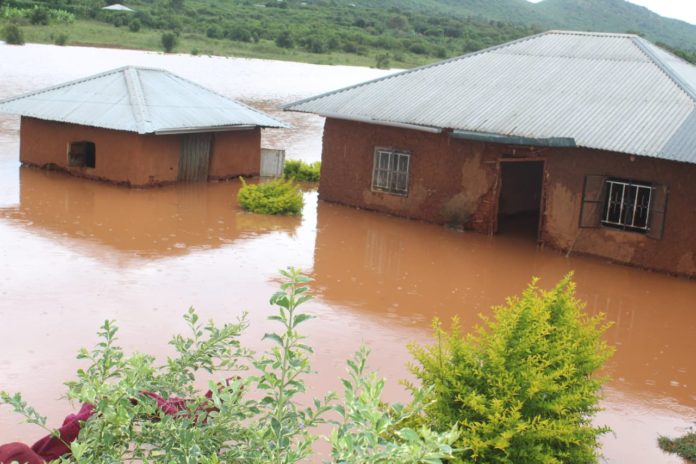BUDALANGI April 5, 2020 — For 54-year-old Esther Anyango, who resides in Maduwa village nestled in the swampy Yala, an island within the Lake Victoria waters is not her choice.
“This time, the waters are too much to bear. This is different from the other floods,” she tells Ubuntu Times in an interview, speaking through a translator, referring to the ongoing flooding in Budalangi, a region that sits on the shores of Lake Victoria.
It has never been Anyango’s delight to endure floods that happen in her village almost every year. Those financially okay, she says, have relocated and established their new residences in much safe land, mostly Bunyala north.
A mother of six, Anyango’s family is one of hundreds displaced due to the ongoing flooding in Budalangi, which experts say is much due to rising water levels at Lake Victoria.
As of March 28, close to 500 families were reportedly affected by flooding, forcing them to seek refuge on safer raised grounds.
Of concern to Anyango and thousands of residents here is how they will balance having to practice self-distancing and handwashing using clean water or sanitizers, now that they have their homes submerged.
“Toilets have been submerged in floodwater. The water is now contaminated and soon, we are foreseeing a cholera outbreak and other water-borne diseases. To worsen it, families are forced to share single rooms in safer places,” Elijah Wanjala, a resident of Mabinju told Ubuntu Times in an interview.
In its Eastern Africa regional flood snapshot for November last year, the United Nations Office for the Coordination of Humanitarian Affairs (UNOCHA) said over 2.8 million people had been affected by the floods.
The floods, which came in the back of consecutive droughts triggered flooding and landslides across the region, destroying homes, infrastructure and livelihoods, and the risk of communicable diseases — including cholera.
In Kenya’s western region, as floodwaters stagnate, potential threats of a water-borne disease outbreak is imminent, threatening to jeopardize the government’s efforts in containing the spread of coronavirus pandemic.
A spot check at one of the trading centers saw businesses brought to a halt, with few remaining shops staring at a possible total closure as the floodwaters continue to occupy the surrounding.
Raphael Wanjala, a Member of Parliament for Budalangi constituency, told Ubuntu Times in a telephone interview that the ongoing floods are likely to complicate the government’s efforts to combat coronavirus spread.

“The flooding threatens to sink the people of Budalangi into deeper poverty. One of the biggest concerns will be managing overcrowding in safety camps where families affected by the raging floods seek refuge,” says Wanjala.
Plagued by heavy rain and flooding over the last few months, with the February flooding leaving 40 dead and 15,000 people displaced, Tanzanian authorities had to order at least 25,000 people to evacuate to safer grounds.
This was after Nyumba ya Mungu dam, located in Mwanga district in the northern Kilimanjaro region, showed signs of breaking due to rising water levels.
Last month, roads in and around the commercial capital, Dar es Salaam were closed due to heavy rains, with a bridge in Kilosa district on the important Morogoro-Dodoma highway collapsing.
A March report by the International Organization for Migration (IOM) indicates that torrential rains caused damage in Mutimbuzi and Kabezi communes in Burundi’s Bujumbura rural province and Nyanza-Lac in Makamba province resulting in two deaths and over 300 people displaced from their homes
Other provinces affected by the torrential rains in Burundi include Rumonge, Gitega and Ruyigi provinces.
The unusual torrential rainfall witnessed in most countries of the East African region within the last quarter of last year, were said to be primarily been driven by the positive Indian Ocean Dipole (IOD)-an irregular oscillation of sea surface temperatures in which the western Indian Ocean becomes alternately warmer (positive phase) and then colder (negative phase) than the eastern part of the ocean.
Budalangi in Kenya, currently witnessing floods is home to a multi-million Bunyala rice irrigation scheme, with fears emerging that continued flooding will disrupt jobs and food security given the timing of the floods which come at the time of planting season.

Leaders say the sudden rising water levels in Lake Victoria could have been occasioned by neighboring Ugandan government’s decision to let off water from its Jinja dam through Kiira and Nalubaale powers stations spillways into the River Nile.
For residents living in villages within the Yala swamp, accessing medical services is a tedious exercise, with the nearest health center located in Osieko, several miles away
“People here live by the mercies of God. For them to access medical care, they have to sail a boat far away. With floods causing havoc, the situation is worsened,” says Collins Ayango, a water and beverage consultant from the region, who is in the process of putting up water treatment and bottling plant, seeking to solve the problem of access to clean portable water for the region’s residents.
Uganda and Kenya are part of the countries that signed the 2010 Cooperative Framework Agreement that allows the development of projects along the Nile without approval from Egypt. Under the framework, the River Nile Basin Commission was established to act as a forum for co-operation and a clearinghouse for the planned measures that could cause any harm to other riparian states.
Collins Ayango told Ubuntu Times that lack of political goodwill in the implementation of infrastructural projects, including building reliable dykes on the River Nzoia that empties its water to Lake Victoria used to contribute to annual floods in Budalangi.
“Until when the World Bank funded construction of concrete dykes few years ago, residents used to witness fatal flooding. The ongoing floods look different from the past. It seems it is being caused by the lake’s backflow,” he says.
Some of the vastly affected areas in Budalangi include Osieko, Maduwa, Bukhuma, Bulwani, Iyanga, Rukala, Runyu, Bubamba. Others are Kholokhongo, Mabinju, Musoma, Rugunya, Omena Beach and Buongo villages.

